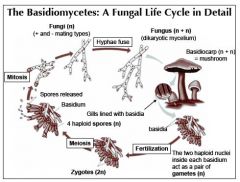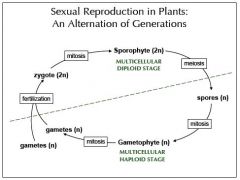![]()
![]()
![]()
Use LEFT and RIGHT arrow keys to navigate between flashcards;
Use UP and DOWN arrow keys to flip the card;
H to show hint;
A reads text to speech;
59 Cards in this Set
- Front
- Back
|
Histones
|
DNA coiled around protein
|
|
|
Chromatin
|
DNA + histone ~ only in eukaryots
|
|
|
Chromatid
|
one condensed DNA molecule
|
|
|
Chromosome
|
individual bodies that form from condensed chromatin
|
|
|
Ploidy
|
sets of chromosomes
Diploid (2n) – cells with 2 complete sets of chromosomes Haploid (n) – a cell with one complete set of chromosomes (n)= ~ a complete set of every gene for a given organism – human n=23; fruit fly n=8; fern n=200 |
|
|
Binary Fission
|
how prokaryots divide
|
|
|
Cell Cycle
|
Interphase – the rest stage between cell division while the cell grows & chromosomes replicate.
Mitosis – 1 mother cell => 2 daughter cells = body cells Prophase – chromosomes condense, spindle appear, nuclear membrane disappears Metaphase – centromeres of chromosomes line up single-file at spindle’s equator (metaphase plate) Anaphase – spindle pulls sister chromatids apart Telophase – spindle disappears & nuclear membranes reappear Cytokinesis – division of cytoplasm |
|
|
Cleavage furrow
|
fibers encircling the cell constrict, pinching off the cell in the middle and forming two new cells ~ in animal cells
|
|
|
Cell plate
|
formed in a plant cell and is the wall that divides daughter cells; formed by the Golgi apparatus
|
|
|
Cancer
|
Mitosis out of control. When the contact inhibition of a cell malfunctions, mitosis continues unchecked
|
|
|
Meiosis
|
Meiosis I (Prophase I, Metaphase I (the difference here give rise to tremendous genetic diversity in gametes), Anaphase I, Telophase I) – homologous separate & ploidy is halved (2n=>n)
Prophase I – chromosomes condense, spindle appears, nuclear membrane disappears. Crossing over happens here. Metaphase I – homologous pairs of chromosomes line up at spindle’s equator. Independent assortment happens here. Anaphase I – homologous chromosomes separate Telophase I – spindle disappears, cytokinesis occurs Meiosis II (Prophase II, Metaphase II, Anaphase II, Telophase II) – happens the same as meitosis Independent Assortment – during Metaphase I, the chromosomes line up in random patterns independent of other pairs Crossing Over – homologous chromosomes exchange a piece of their DNA |
|
|
Gregor Mendel
|
Father of modern genetics
|
|
|
Gene
|
a segment of DNA molecule that contains instructions for making a polypeptide ~ the basic unit of inheritance
|
|
|
Genotype
|
genetic makeup
|
|
|
Phenotype
|
physical traits
|
|
|
Allele
|
variants of a gene
|
|
|
Dominant/Recessive
|
one allele dominates over another and the recessive allele will not be expressed. Recessive alleles will only be seen if both alleles are recessive.
|
|
|
Homozygous
|
when both alleles are identical
|
|
|
Heterozygous
|
when alleles are different
|
|
|
P Generation
|
The true-breeding parents are referred to as the P generation
|
|
|
F1 Generation
|
The first hybrid offspring are the F1 generation
|
|
|
F2 Generation
|
The offspring of a self-fertilizing F1 hybrid is called the F2 generation
|
|
|
Punnett Square
|
The Punnett Square is a simple way of showing the probability of getting certain genotypes and phenotypes from a mating event
|
|
|
Incomplete Dominance
|
F1 hybrids have a phenotype that is intermediate to that of the parental phenotypes
|
|
|
Codominance
|
Both parental phenotypes are expressed simultaneously in the F1 hybrid
|
|
|
Polygenic Inheritance
|
Many traits, however, are determined by polygenic inheritance: two or more genes acting together
|
|
|
How is the DNA found in prokaryotic cells different from the DNA found in eukaryotic cells?
|
Prokaryots have a singular DNA molecule in cytoplasm while eukaryots have multiple linear DNA molecules in a nucleus.
|
|
|
How do prokaryotic cells divide?
|
Binary fission
|
|
|
3. What is the difference between chromatin, chromatid, and chromosome?
|
a. Chromatin – DNA + histone ~ only in eukaryots.
b. Chromatid - one condensed DNA molecule c. Chromosome – individual bodies that form from condensed chromatin |
|
|
4. What are the major stages of the cell cycle? What is happening during interphase?
|
a. Interphase – the resting stage between cell division
b. Mitosis - 1 mother cell => 2 daughter cells = body cells c. Cytokinesis- -division of cytoplasm |
|
|
5. What are the main stages of mitosis? What is happening in each of these stages?
|
a. Prophase – chromosomes condense, spindle appear, nuclear membrane disappears
b. Metaphase – centromeres of chromosomes line up single-file at spindle’s equator (metaphase plate) c. Anaphase – spindle pulls sister chromatids apart d. Telophase – spindle disappears & nuclear membranes reappear |
|
|
6. How many daughter cells are produced from the parent cell during mitosis, and what happens to the ploidy? How does this compare to meiosis?
|
a. Mitosis => 2 daughter cells & ploidy = no changes
b. Meiosis => 4 daughter cells & ploidy is halved |
|
|
7. What is the relationship between mitosis/meiosis and cytokinesis? What is a cleavage furrow and what kind of cells produce it? What is a cell plate, and what kind of cells produce it? Which organelle is responsible for generating the cell plate?
|
a. Mitosis is 1 mother cell => 2 daughter cells for body cells in animals while Meiosis is 1 mother cell => 4 daughter cells for gametes in animal cells
b. Cleavage furrow – fibers encircling the cell constrict, pinching off the cell in the middle and forming two new cells ~ in animal cells c. Cell plate is formed in a plant cell and is the wall that divides daughter cells d. Golgi apparatus generates the cell plate |
|
|
What is cancer?
|
Mitosis out of control
|
|
|
9. What are the stages of meiosis, and what is happening in each?
|
a. Meiosis I (Prophase I, Metaphase I (the difference here give rise to tremendous genetic diversity in gametes), Anaphase I, Telophase I) – homologous separate & ploidy is halved (2n=>n)
b. Prophase I – chromosomes condense, spindle appears, nuclear membrane disappears. Crossing over happens here. c. Metaphase I – homologous pairs of chromosomes line up at spindle’s equator. Independent assortment happens here. d. Anaphase I – homologous chromosomes separate e. Telophase I – spindle disappears, cytokinesis occurs |
|
|
10. What is independent assortment? What is crossing over? During what stages of meiosis do these events occur? How do these events insure that all the gametes produced by meiosis are genetically different?
|
a. Independent Assortment – during Metaphase I, the chromosomes line up in random patterns independent of other pairs. Along with Crossing Over, gives rise to variations among individuals in a population of a given species.
b. Crossing Over – during Phrophase I, homologous chromosomes exchange a piece of their DNA. This produces 4 unique gametes. |
|
|
11. What is an allele? What is the difference between a dominant allele and a recessive allele?
|
a. Allele – variants of a gene
b. Dominant/Recessive – one allele dominates over another and the recessive allele will not be expressed. Recessive alleles will only be seen if both alleles are recessive. |
|
|
12. What is the difference between genotype and phenotype?
|
a. Genotype – genetic makeup
b. Phenotype – physical traits |
|
|
15. How do we know which chromosomes match up?
|
a. Size
b. Location of centromere c. Banding pattern (seen after staining) |
|
|
Kingdom Fungi
|
Eukaryotes with cell walls of chitin; Nonmotile, and lack flagellated stages; Heterotrophic by absorption; Multicellular stage of their life cycle is haploid
|
|
|
Heterotrophy by absorption
|
secrete powerful digestive enzymes outside their bodies; biomolecules are hydrolyzed in the environment, and the monomers are absorbed through the fungal cell walls
|
|
|
Hypha/Hyphae
|
Multicellular fungi grow as tiny branching filaments known as hyphae;
|
|
|
Mycelium
|
hyphae form an interwoven mass known as a mycelium that surrounds and infiltrates whatever the fungus is feeding on
|
|
|
Spores
|
A basidiospore is a reproductive spore produced by Basidiomycete fungi. Basidiospores typically each contain one haploid nucleus that is the product of meiosis, and they are produced by specialized fungal cells called basidia
|
|
|
Basidiocarp
|
The sexual reproductive structure of the basidiomycetes is the basidiocarp, or mushroom
|
|
|
What are the main stages and features in the life cycle of a fungus?
|

|
|
|
What are Basidiomycetes?
|
Club Fungi (Basidiomycota)
|
|
|
What is a basidiocarp, and what is its function?
|
The sexual reproductive structure of the basidiomycetes is the basidiocarp.
|
|
|
What are antibiotics, and why do fungi produce these compounds?
|
Fungi and bacteria: often in close quarters and in close competition; some fungi developed compounds that kill bacteria; Anitbacterial compounds give fungi a competitive edge
|
|
|
Penicillin
|
the compound isolated from the fungus Penicillium that was able to kill the bacteria was named penicillin; Penicillin attacks the compound peptidoglycan, so it proved highly effective at killing gram-positive bacteria like Staphylococcus
|
|
|
Mycosis
|
a fungal infection
|
|
|
Alternation of Generations
|
Life cycle alternates between a diploid and haploid
multicellular form (“Alternation of generations”) |
|
|
Sporophyte
Gametophyte |
plant - phyte; spores (2n)
Gametophyte = plant gametes (n) |
|
|
Vascular tissue
|
Vascular refers to vessels, transport water ro sugar
Two types of vascular tissues in plants: – Xylem- transports water – Phloem- transports a sugar solution called sap |
|
|
Mosses (Bryophytes)
|
lacks vascular tissue
|
|
|
What are the defining characteristics of Kingdom Plantae?
|
Multicellular eukaryotes that possess a cell wall
made of cellulose – Photoautotrophic – Life cycle alternates between a diploid and haploid multicellular form (“Alternation of generations”) |
|
|
What is meant by the term photoautotrophic?
|
they make their monomer using light - process using phtosysthesis
|
|
|
What are the four major groups of plants? Which of these are vascular plants? Which are seed plants?
|
four major groups:Bryophytes (Mosses) Pterophytes (Ferns)Gymnosperms (Cone-bearing plants) Angiosperms
(Flowering plants) |
|
|
plant cell life cycle
|

|

